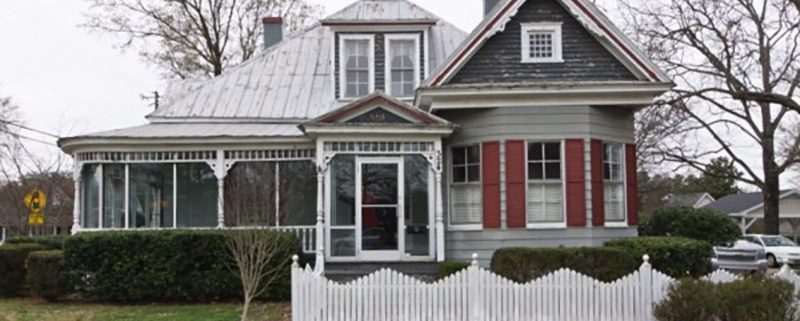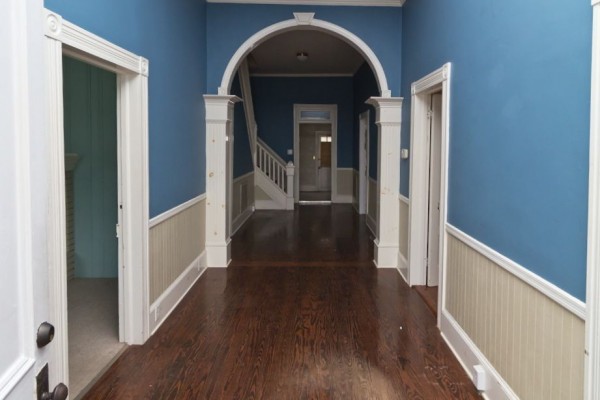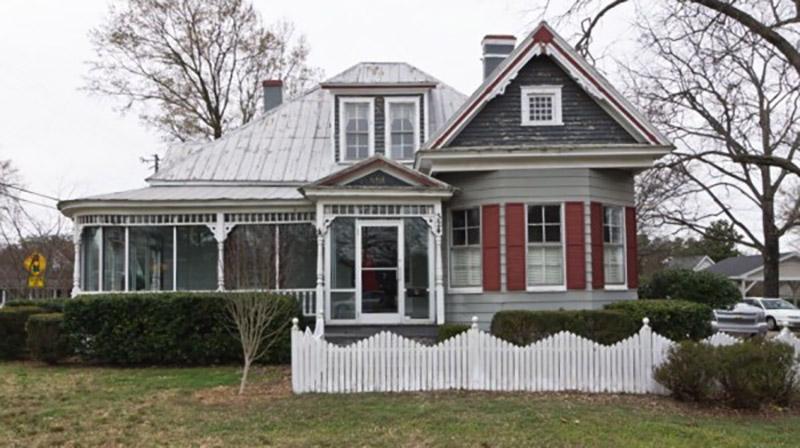Jones House Gets New Name, Landmark Designation
Cary, NC – The Jones House has a long connection to Cary’s history, from its rare architectural form in town to the tradition of Cary High School principals living there. As the Jones House recently gained designation as a historic landmark, new information about the building’s history was uncovered, resulting in it getting a more historically-accurate name.
The Sams-Jones House
The Jones House is located at 324 S Academy St., across from the Cary Arts Center, which was originally Cary High School. Lovie Jones bought the house in 1914 and it remained in the family for several decades until eventually the Town of Cary came into ownership in 2011.
But in a staff report to apply for a Historic Landmark Designation, architectural historian Cynthia de Miranda with MdM Historical Consultants uncovered more information about the Jones house and its original owner. Before the Jones family, the house was built by Andrew Fuller Sams.
“The owners before Sams just owned the land and we found a portion of the land was sold to Sams in around 1902,” said Anna Readling, senior planner with the Town of Cary. “Sams bought the land for $400 and years later, he sold the land for much more so it makes sense that he built the house in that time. We put together the chain of information.”
Because of this new information, the new historic name for this building is the Sams-Jones House.
“This information is as new as the landmark report,” Readling said. “[Cynthia de Miranda] did the deed research and it was not easy. Sometimes there are just little things in the database to search for and you have to deal with things such as names that are spelled differently.”
Andrew Fuller Sams began teaching at Cary High School in 1897 when he was around 25 years old. Four years later, he was the school’s principal and, in a way, started the tradition of principals living in the Sams-Jones House. E.L. Middleton, the principal before Sams, said “the school was never more successful that during the last term under his management,” according to the staff landmark report.
By 1903, Sams had left his principal position to go to law school and spent the rest of his life living in Davidson County.
“Sams was known about but a lot of information about him wasn’t clear. We weren’t sure about who built the house,” Readling said. “Until now.”
Landmark Status
As a Town of Cary-owned property, Readling said the Sams-Jones House was already being cared for and restored but now the building is a designated historic landmark in Cary.
“It calls attention to the house in a way that it wasn’t before,” Readling said. “We get people new to Cary who ask about landmarks and historic sites. This gives a name to a building and makes people take pause and think about it.”
Part of what gives the Sams-Jones House so much importance in Cary, aside from its connection to the old Cary High School, is its architecture. The Sams-Jones House is made in the Queen Anne style.
“There aren’t many original Queen Anne houses or cottages left in Cary with their traditional features,” Readling said.
Downtown Cary does have one other prominent example of Queen Anne architecture, Readling said, with the Guess-Ogle House. But these are two of the few examples in all of Cary.
“As we get new landmarks, we hope to have more tours of Cary and let people know about the history,” she said. “It also sets a precedent that history is important here.”
While the Sams-Jones House is now a designated historic landmark, the town is still seeking commercial tenants for the building.
Also recently gaining historic landmark designation is the Cary Arts Center and the Nathaniel Jones Cemetery.
Story by Michael Papich. Photos by Brooke Meyer.






Barbara,
see:
http://carycitizen.com/2017/12/11/sams-jones-house-gets-potential-new-tenant/
Your assumptions about A.F.Sams are incorrect. He graduated from Wake Forest in 1897 and became teacher and principal at Marshville Academy and DID NOT come straight to Cary as this article says. He was for lack of a better term ‘assistant principal’ to E.L. Middleton who toyed with the idea of going to the Baptist State convention but returned to full time Principal around 1904 and Sams moved on. The house WAS NOT built by Sams. Deeds and real estates records under wakegov.com clearly show James Jones built the house in 1890. Sams may have owned ‘some’ of the land but NEVER built a house there or anywhere else in Cary. Check your facts before renaming this house.
The new information that led to the Sams-Jones House being renamed can be found in the Town of Cary’s staff report: http://carync.iqm2.com/Citizens/Detail_Meeting.aspx?ID=2669
If you disagree with any of the information the Town of Cary and MdM Historical Consultants found, that is who you should talk to.
What business is going into the Sams-Jones House and when? It has set empty way to long.
Does the historical designation preclude someone from adding a well done, functional addition to the back? I’m thinking of the Old Pink House in Savannah….a Cary version.
Hello Johnny. This was brought up during the Town Council meeting, which is linked to in the article. In short, any changes would have to go before the Historic Preservation Commission, not unlike the process the Cary Arts Center went through when its most recent wings were added on. Hope that clears things up.
Additionally, nothing would prevent a modification – the modification/addition/etc would just need to match the style existing for the period. I am not a fan of the historical preservation of much of anything, but I get it, and I was glad to hear our At-Large council member, Lori Bush, speak up and make it clear that the status of this property will not prevent anything from happening on the property. The last thing any of us wants is a historical property that is useless (and yeah, I’ll point at the Ivy-Ellington house on Chatham).
Cary’s Historic Preservation Commission has jurisdiction over modifications to Cary Historic Landmarks, such as the recently designated Sams-Jones house. If modifications are proposed, the HPC holds a hearing to determine if the proposed changes are congruent with the Town’s adopted guidelines. This is an objective finding of fact. The guidelines are public and the HPC votes on whether the proposal meets the guidelines. A rear addition is certainly possible if it conforms to the guidelines.